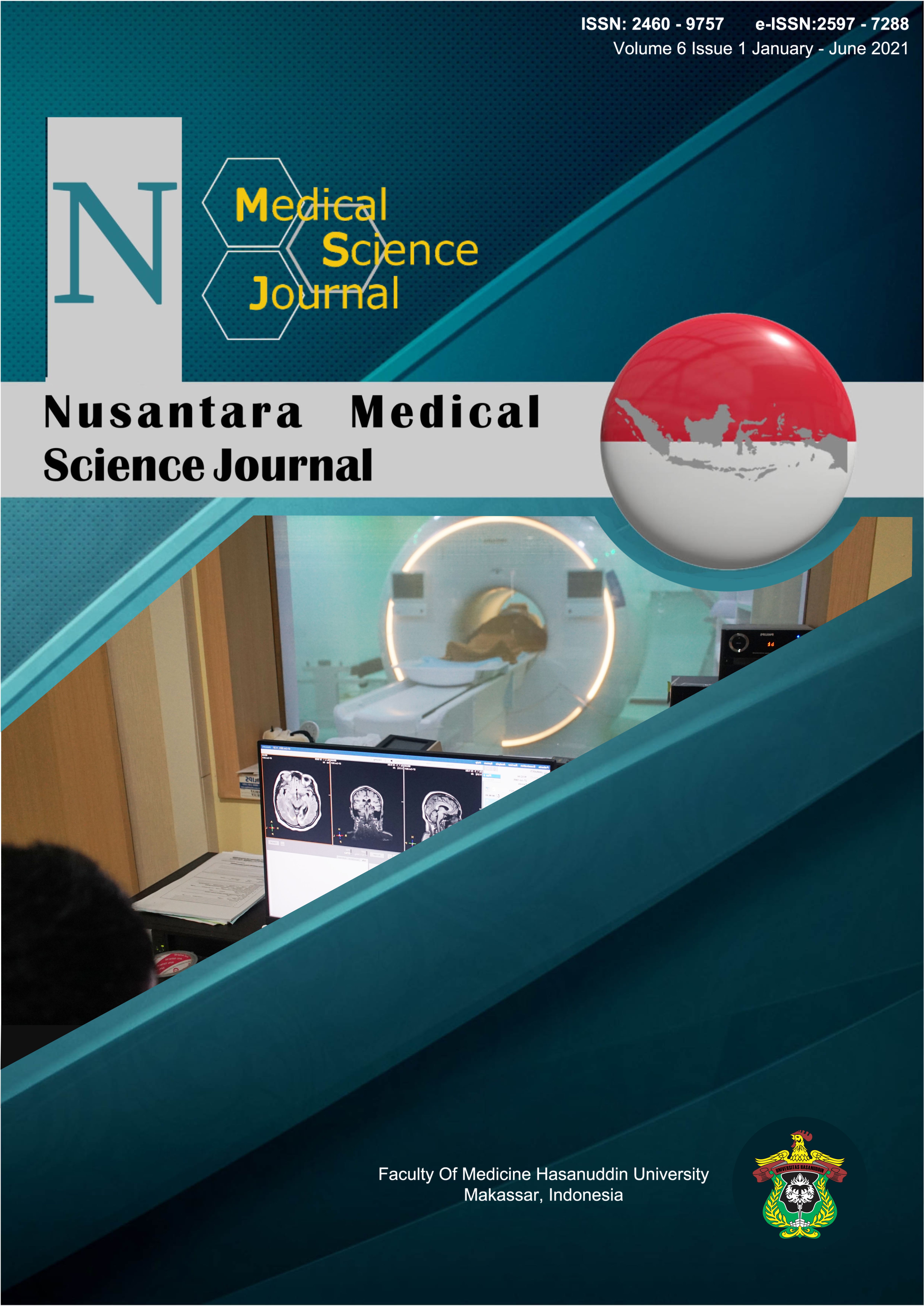The Effectiveness Between Tamsulosin and Solifenacin Combined with Tamsulosin on Treatment of Ureteral Stent-Related Symptoms
DOI:
https://doi.org/10.20956/nmsj.v6i1.14263Abstract
Introduction: The clinical usage of the ureteral stent caused several stent-related symptoms (SRSs), including lower urinary tract symptoms, pain, general health, work performance, sexual matter and additional problems. This study aims to evaluate the effectiveness between tamsulosin and solifenacin combined with tamsulosin for SRSs.
Methods: This double blind randomized controlled trial used 50 patients. Between September 2020 and February 2021, patients underwent double-J stenting after retrograde ureteroscopy were analyzed. All patients would be randomized in a 1:1 ratio in a 1:1 ratio to receive either tamsulosin 0,4 mg (Group A: 25 participants) or tamsulosin 0,4 mg & solifenacin 5 mg combination (group B: 25 participants).We used the Ureteral Symptoms Score Questionnaire (USSQ) as an outcome measure at 1s, 2nd, 3rd and 4th weeks after stent insertion. Results: Group A was found more in women, while in group B was more in men. The highest age in group A and group B was 50-60 years old (36% and 64%). The location of stenting in group A was found more in left (60%), while the group B in the right (52%). Both groups had more patients who were normal nutritional status (60%). There was an improvement in pain and work performance after treatment in both groups, meanwhile group B showed better improvement than group A at all weeks. in addition, there was an improvement in urinary symptoms and sexual matter in group B better than in group A at 2nd to 4th week. Furthermore, group B showed better improvement in general health and additional problem only at 4th week. Conclusions: Combination therapy with tamsulosin and solifenacin improved USSQ score more than the monotherapy group. This implied that combination therapy is optimal for improving SRSs.
References
Ahallal Youness, Khallouk Abdelhak, Jamal Mohammed, Hassan farih (2010). Risk Factor Analysis and Management of Ureteral Double-J Stent Complications. Rev Urol. 2010 Spring-Summer; 12 (2-3): e147.
Park Jinsung et al (2015). A critical assessment of the effect of tamsulosin dan solifenacin as monotherapies and as a combination therapy for the treatment of ureteral stent-related symptoms: a 2 x 2 factorial randomized trial. World Journal of urology. Published March 26 2015. DOI 10.1007/s00345-015-1544-1
Betschart Patrick, et al (2017). Prevention and treatment of symptoms associated with indwelling ureteral stents: a systematic review. International Journal of Urology 24.4 (2017): 250-259.
Wang Jue et al. (2017). The role of solifenacin, as monotherapy or combination with tamsulosin in ureteral stent-relates symptoms: a systemativ review and meta-analysis. World Journal of Urology. Published online 26 May 2017. DOI 10.1007/s00345-017-2051-3
Song, Y., Chen, G., Huang, P., Hu, C., & Liu, X. (2020). Effects of Tamsulosin Combined With Solifenacin on Lower Urinary Tract Symptoms: Evidence From a Systematic Review, Meta-Analysis, and Trial Sequential Analysis of Randomized Controlled Trials. Frontiers in Pharmacology, 11. doi:10.3389/fphar.2020.00763
Gong, M., Dong, W., Huang, G., Gong, Z., Deng, D., Qiu, S., & Yuan, R. (2015). Tamsulosin combined with solifenacin versus tamsulosin monotherapy for male lower urinary tract symptoms: a meta-analysis. Current Medical Research and Opinion, 31(9), 1781–1792. doi:10.1185/03007995.2015.1074067
Lim Kyoung et al (2011). Effect of tamsulosin, solifenacin dan combination therapy for the treatment of ureteral stent related discomforts. Department of Urology, Hangyang University College of Medicine, Seoul, Korea. Korean Journal of Urology. DOI: 10.4111/kju.2011.52.7.485
Yan, H., Wang, Y., Sun, R., & Cui, Y. (2016). The Efficacy of Antimuscarinics Alone or in Combination with Alpha-Blockers for the Treatment of Ureteral Stent-Related Symptoms: A Systematic Review and Meta-Analysis. Urologia Internationalis, 99(1), 6–13. doi:10.1159/000449390
Gao Yiyang et al (2019). Comparison of Alpha-Blockers and Antimuscarinics in Improving Ureteral Stent-Related Symptoms: A Meta-Analysis. Urol J 2019 Jun 17;16(3):307-311. doi: 10.22037/uj.v0i0.4142.
Jian Zhongyu et al (2018). Combination of solifenacin dan tamsulosin may provide additional benefical effects for ureteral stent-related symptoms-outcomes from a network meta-analysis. World Journal of Urology. Published online: 20 July 2018. https://doi.org/10.1007/s0034
Dellis Athanasios et al (2017). Tamsulosin, solifenacin and their combination for the treatment of stent-related symptoms: a randomized controlled study. National and Kapodistrian Universoty of Athens, School of medicine, Aretaieion Hospital. Journal of Endourology. DOI: 10.1089/end.2016.0663.
Downloads
Published
How to Cite
Issue
Section
License
Copyright (c) 2021 Nusantara Medical Science Journal

This work is licensed under a Creative Commons Attribution 4.0 International License.









